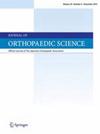第二和第三跖骨长度的差异与拇指外翻患者第二跖趾关节脱位或关节炎病变的风险有关。
IF 1.4
4区 医学
Q3 ORTHOPEDICS
引用次数: 0
摘要
背景:第二跖骨头(2 MH)上的慢性机械应力可能是导致拇指外翻(HV)患者骨关节炎(OA)和第二跖趾关节脱位(2MTPJ)的危险因素。本研究旨在调查 HV 患者第二跖趾关节的应力分布,并确定与第二跖趾关节脱位和 OA 相关的因素:方法:对总共 115 例 HV 足进行回顾性研究,并将其分为两组:2MTPJ 下脱位或脱位组(D 组,27 例)和非脱位组(N 组,88 例)。对照组(C 组)包括 33 只没有 HV 的脚。N 组根据 2MTPJ 是否存在 OA 分为 OA 组和非 OA 组(NOA)。在术前计算机断层扫描图像的矢状切片上测量 2 MH 软骨下骨的 HU 值,然后除以舟骨区域的 HU 值(HU 比值)。比较了 HU 比值与放射学参数之间的关系:在 N 组中,第二跖骨相对于第三和第四跖骨(M2-M3、M2-M4)的突出分别与背侧和中央的 HU 比值呈正相关。OA 组的 HVA、第一-第二跖骨间角、M2-M3、M2-M4 以及背侧和中央 HU 比率均明显大于 NOA 组。比较 D 组和 N 组时,M2-M3 的临界值为 5.5 毫米,比较 OA 组和 NOA 组时,临界值为 4.4 毫米:结论:严重HV、M2-M3和M2-M4较长可能与2MTPJ脱位和OA的高风险有关:Ⅲ.本文章由计算机程序翻译,如有差异,请以英文原文为准。
The difference in second – third metatarsal length is associated with the risk of dislocation or arthritic change in the second metatarsophalangeal joint in patients with hallux valgus
Background
Chronic mechanical stress on the second metatarsal head (2 MH) can be a risk factor for osteoarthritis (OA) and dislocation of the second metatarsophalangeal joint (2MTPJ) in hallux valgus (HV). This study aimed to investigate the stress distribution of the 2 MH in HV patients and determine the factors associated with dislocation and OA of the 2MTPJ.
Methods
In total, 115 feet with HV were retrospectively reviewed and divided into two groups: those with subluxation or dislocation of the 2MTPJ (group D, 27 feet) and those without (group N, 88 feet). The control group (group C) included 33 feet without HV. Group N was divided into OA and non-OA (NOA) groups according to the presence or absence of OA of the 2MTPJ. The Hounsfield Unit (HU) value of the subchondral bone of the 2 MH was measured on sagittal slices of the preoperative computed tomography images and divided by the HU value of the navicular region (HU ratio). The relationship between the HU ratios and radiographic parameters was compared.
Results
The HU ratios were significantly higher in group N than those in groups C and D. In group N, the protrusion of the second metatarsal relative to the third and fourth metatarsals (M2-M3, M2-M4) was positively correlated with the dorsal and central HU ratios, respectively. Group D had a significantly larger HV angle (HVA) and M2-M3 than group N. HVA, the first-second intermetatarsal angle, M2-M3, M2-M4, and dorsal and central HU ratios were significantly larger in the OA group than in the NOA group. The cutoff value of M2-M3 was 5.5 mm when comparing groups D and N, and 4.4 mm when comparing the OA and NOA groups.
Conclusions
Severe HV and a longer M2-M3 and M2-M4 may be associated with a high risk of dislocation and OA of the 2MTPJ.
Level of evidence
Ⅲ
求助全文
通过发布文献求助,成功后即可免费获取论文全文。
去求助
来源期刊

Journal of Orthopaedic Science
医学-整形外科
CiteScore
3.00
自引率
0.00%
发文量
290
审稿时长
90 days
期刊介绍:
The Journal of Orthopaedic Science is the official peer-reviewed journal of the Japanese Orthopaedic Association. The journal publishes the latest researches and topical debates in all fields of clinical and experimental orthopaedics, including musculoskeletal medicine, sports medicine, locomotive syndrome, trauma, paediatrics, oncology and biomaterials, as well as basic researches.
 求助内容:
求助内容: 应助结果提醒方式:
应助结果提醒方式:


